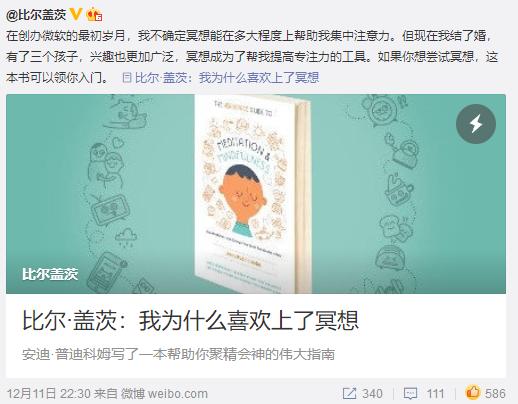
在我20来岁的时候,我不再听音乐和看电视了。这听上去有点极端,但当时我觉得它们会分散注意力,让我没法专心开发软件。不过后来我只坚持了五年。现在的我特别喜欢看《毒枭》这样的电视节目,平时也经常听 U2乐队、威利·纳尔逊和甲壳虫乐队的音乐。
远离音乐和电视的那段时间里,我知道许多人会通过冥想来集中注意力,但我没有兴趣。冥想似乎和转世轮回有关,有点玄乎,所以我并不相信。
不过最近,我对冥想有了更深的理解。我不是什么专家,但每周我会冥想两到三次,每次大约 10 分钟。梅琳达也在练习冥想。有时候我们会坐下来一起练习(我们是坐在舒适的椅子上,我可绝对做不出莲花坐)。
现在我明白了,冥想只是在锻炼我们的大脑,就好比运动是在锻炼我们的肌肉。对我来说,冥想与信仰和玄学无关。我只需抽出几分钟时间,学着关注脑海中的思绪,然后与它们保持一定距离。
46 岁的安迪·普迪科姆(Andy Puddicombe)是热门应用Headspace的联合创始人和配音,是他让将信将疑的我变成了一名信徒。发现Headspace之前,我读过好几本介绍冥想的书,但每本都让我望而生畏。书中的描述让我觉得,学习冥想要投入的时间和精力成本实在太高了。Headspace则为我降低了门槛。每天我只需抽出 10 分钟,听着安迪柔和的英式口音,然后试着照他说的去做。安迪的简易入门法受到了不少冥想发烧友的指责,但他让我喜欢上了冥想并坚持至今。我很高兴他做到了。
如果你也想尝试冥想(特别是如果你也像过去的我一样半信半疑),有个很好的办法可以领你入门:读一读安迪的书《冥想与正念入门指南》(The Headspace Guide to Meditation and Mindfulness,中文名暂译)。安迪的叙事手法老道,常常运用隐喻来解释深奥的概念,轻松易懂。书中穿插了名为“研究结果”的小版块,介绍了冥想实践背后的科学依据,让人明白练习冥想确有益处。安迪是一名佛教僧人,曾在印度、尼泊尔、缅甸、泰国、澳大利亚、俄罗斯和苏格兰的寺院里接受过多年训练。
安迪开篇就描述了自己在其中一座寺庙里的经历:“我整日整夜被关在里面,困在高墙之下,无法与外界联系,有时感觉这里更像是一座监狱。”
在另一所寺庙里,僧人每天都给学徒供应咖喱和米饭,让他们用刚好一小时的时间吃完。有一天酷热难当,僧人在每个学徒面前放了一个冰淇淋,令大家惊喜不已。“那就好像你是个参加生日派对的小孩,而这时候蛋糕出现了。”不幸的是,学徒们发现他们必须先用极慢的速度吃完咖喱和米饭,然后才能吃冰淇淋。看着冰淇淋在眼前慢慢融化,他感到愤怒,接着又为感到愤怒而觉得难过和内疚——这一切正如僧人所料。
安迪发现僧侣生活并不适合自己。我们从书中获知,10年后他离开了寺院,然后到伦敦当起了马戏团小丑——我没有骗你。他希望全身心地融入这个世界,而不是把自己关在人为创造的静修之地。
做马戏团小丑时,他开始教那些有严重焦虑症的人冥想。几年后他创办了 Headspace,把冥想介绍给了普罗大众。他认为冥想是人人都能学会的技能,学员不必坐在高墙之下练习,或是被心理游戏糊弄。
梅琳达和我都很喜欢安迪的书和应用,所以我们联系了他,问他是否愿意指导我和我的家人。他欣然同意,这让我们感到非常高兴。安迪用了一天半的时间,带领我和梅琳达以及我们的两个孩子完成了一些练习,你在书里能找到类似的练习。安迪热情、谦虚、实在,与我们从他的书和配音中联想到的一模一样。
在创办微软的最初岁月,我不确定冥想能在多大程度上帮助我集中注意力,因为我那时不用冥想就已经非常专注了。但我现在结了婚,有了三个孩子,职业和个人层面的兴趣也更加广泛,于是冥想成了很好的工具,可以帮我提高专注力。它还可以帮助我从当下的状态中后退一步,不论正在经历怎样的思绪和情绪,都能获得一些缓和。每隔几天就冥想10分钟,这让我收获良多。我感谢安迪在我这趟旅程中给予的帮助。

Why I’m into meditation
By Bill Gates
I stopped listening to music and watching TV in my 20s. It sounds extreme, but I did it because I thought they would just distract me from thinking about software. That blackout period lasted only about five years, and these days I’m a huge fan of TV shows like Narcos and listen to a lot of U2, Willie Nelson, and the Beatles.
Back when I was avoiding music and TV in the hope of maintaining my focus, I knew that lots of other people were using meditation to achieve similar ends. But I wasn’t interested. I thought of meditation as a woo-woo thing tied somehow to reincarnation, and I didn’t buy into it.
Lately, though, I’ve gained a much better understanding of meditation. I’m certainly not an expert, but I now meditate two or three times a week, for about 10 minutes each time. Melinda meditates too. Sometimes we sit to meditate together. (We use comfortable chairs; there’s no way I could do the lotus position.)
I now see that meditation is simply exercise for the mind, similar to the way we exercise our muscles when we play sports. For me, it has nothing to do with faith or mysticism. It’s about taking a few minutes out of my day, learning how to pay attention to the thoughts in my head, and gaining a little bit of distance from them.
Andy Puddicombe, the 46-year-old cofounder and voice of the popular Headspace app, was the person who turned me from skeptic to believer. Prior to finding Headspace, I had read several books about meditation, all of which intimidated me. They made me think that the investment in terms of time and energy was just too high. Headspace made the barrier to entry low enough for me. It’s just 10 minutes a day of listening to Andy’s soothing British accent and trying to stay with him. Andy has taken some heat from hard-core meditators for his low-barrier approach, but he got me to take up meditation and stick with it. I’m glad he did.
If you want to try meditation for yourself, one good way to ease into it—especially if you’re as skeptical as I was—is to pick up a copy of Andy’s book, The Headspace Guide to Meditation and Mindfulness. Andy’s a witty storyteller and offers lots of helpful metaphors to explain potentially tricky concepts, which makes the book an easy, enjoyable read. Andy presents the evidence base behind these practices in sections called “What the research shows” so you know the benefits are legitimate. And the book also helps you see that Andy himself is legitimate. He’s an ordained Buddhist monk who trained for many years in hard-core monasteries in India, Nepal, Myanmar, Thailand, Australia, Russia, and Scotland.
The book begins with Andy describing one of them: “Locked in, day and night, surrounded by high stone walls and with no way of contacting anyone on the outside, at times it had felt more like a prison.”
At another monastery, the monks served trainees curry and rice every day, and they made the trainees eat it very slowly over the course of exactly an hour. One super hot day, the monks placed in front of each trainee a wonderful surprise: ice cream. “It was like being a child at a birthday party when the cake comes out.” Unfortunately, the trainees soon discovered they were not allowed to touch the ice cream until they had eaten their curry and rice in the painfully slow way they’d been taught. As the ice cream melted in front of him, he felt angry, then sad and guilty for feeling angry—just as the monks knew would happen.
It turns out that monastic life wasn’t right for Andy. As we learn in the book, after ten years he left and—I kid you not—became a circus clown in London. He wanted to be fully engaged in the world rather than cloistering himself away in artificially quiet retreats.
While he was a clown, he started teaching meditation to those with severe anxiety and other conditions. A few years later, he started Headspace to bring meditation to the masses. He felt that meditation was a skill everyone could learn without sitting behind high stone walls or being subjected to mind games.
Melinda and I enjoyed Andy’s work so much that we reached out to him to see whether he might be willing to spend some time teaching our family. He was glad to do it, which was a real treat for us. For a day and a half, Andy helped us and two of our kids through exercises that are similar to the ones you’ll find in the book. Andy was just as warm, humble, and real as we’d imagined from reading his book and listening to him on the app.
I’m not sure how much meditation would have helped me concentrate in my early Microsoft days, because I was monomaniacally focused without it. But now that I’m married, have three children, and have a broader set of professional and personal interests, it’s a great tool for improving my focus. It’s also helped me step back and get some ease with whatever thoughts or emotions are present. I like what I’m getting from my 10 minutes every few days. I’m grateful to Andy for helping me on this journey.